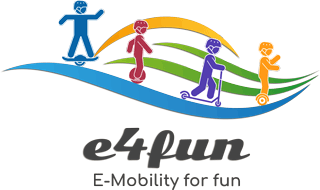e4fun E-Scooter – Backpack
incl. VAT
- Wer darf wo fahren
- Technische Daten
Austria
In Austria, electric scooters are legally classified as electric bicycles. Electric scooters may be used on public roads and cycle paths if the following conditions are met:
Maximum speed of 25 km/h (12 mph)
Maximum motor power of 600 watts
2 side reflectors (white or orange), white front reflector, red rear reflector
Compulsory helmet for children under 12 years of age
Horn or bell
Headlight, rear light
The following are not required:
A driver's license (unlike the requirement for a moped license)
A numberplate
Indicators
Furthermore, such E-scooters may only be parked on the pavement if it is at least 2.5 metres wide.
The legal framework is constantly changing in all European countries. We therefore do not assume any liability for the accuracy and timeliness of the information!
United Kingdom
E-scooters, hoverboards and hovershoes may be used on private land provided that the land owner grants permission. Since such powered transporters may only be used on private land, there are no laws governing maximum speed, minimum age, brakes, insurance plates, driver’s licences, helmets or indicators.
In the United Kingdom, it is currently illegal to use “powered transporters”, which includes e-scooters, segways, hoverboards, hovershoes, on any public road or space dedicated for use by pedestrians, cyclists and horse riders.
For any vehicle to use public roads lawfully, it must comply with technical standards, be insured, taxed, licensed and registered and the driver must be tested before being allowed on the road. Since e-scooters, hoverboards and hovershoes do not conform with any of these stipulations, it is illegal to drive them on the road.
Powered transporters are also prohibited from using pavements and pedestrian-only areas by section 72 of the Highway Act 1835, which states that it is illegal to ride any form of “carriage” (which applies to all motorised vehicles except mobility scooters and wheelchairs) on the pavement. The Road Traffic Act 1988 moreover prohibits the use of powered transporters on footpaths.
Cycle lanes are also out of bounds for powered transporters according to section 21 of the Road Traffic Act 1988, which states that only pedal cycles (with an exemption for mobility scooters) may use such spaces.
https://www.techadvisor.co.uk/buying-advice/gadget/electric-scooter-law-uk-3668712/
The legal frameworks surrounding the use of powered transporters are constantly changing in every country in Europe. We accept no liability for the accuracy of the information provided, which may not be up-to-date.
Germany
In Germany, we now finally have clarity over the use of electric scooters. On 25th February 2019, the Federal Minister of Transport, Andreas Scheurer, signed an ordinance (Ordinance on the Participation of Small Electric Vehicles (PLEVs) in Road Traffic), which from spring 2019 permits the use of e-scooters on the road, on cycle paths and in traffic-calmed areas under the following conditions:
Maximum speed of 20 km/h (12 mph)
Minimum age of 14 years
The electric scooter must have a handlebar
Horn or bell
2 independent brakes
Insurance disc
The following are not required:
A driver's license (unlike the requirement for a moped license)
Wearing a helmet
A numberplate
Indicators
Draft Ordinance on the Participation of Small Electric Vehicles (PLEVs) in Road Traffic
The legal framework is constantly changing in all European countries. We therefore do not assume any liability for the accuracy and timeliness of the information!
Belgium
Speed limits
Up to about 6 km/h (the speed of a walker), the user is considered a pedestrian and can therefore use the sidewalk. But if he exceeds this limit, Belgian law considers him a cyclist. It must then be confined to bicycle paths or, failing that, to the road.
Belgian legislation also requires cars to be restricted to 18 km/h, even if some models easily exceed this level. The user caught speeding risks the confiscation of his vehicle. However, this limit will be raised to 25 km/h by the Vias Road Safety Institute on 1 January 2021.
Required control and responsibility
On the insurance side, most companies have adapted, including micro-mobility vehicles in the mandatory family civil liability. As for cyclists, wearing a helmet and a brightly coloured chasuble is not mandatory, but strongly recommended. No permit is required either, even if the implementation of a certificate of aptitude is under consideration.
https://www.belgium.be/fr/mobilite/autres_vehicules/engins_de_deplacement
https://www.belgium.be/fr/mobilite/cyclistes_et_pietons/cyclistes/obligations
The legal framework is constantly changing in all European countries. We therefore do not assume any liability for the accuracy and timeliness of the information!
Switzerland
Electric scooters are generally permitted in Switzerland, but under slightly different conditions to those in Austria. On the whole, electric scooters can be ridden in Switzerland wherever bicycles may be used. It is therefore compulsory to use cycle paths and cycle lanes. For the Swiss, electric scooters or electric scooters are classified as light motorcycles and must therefore meet the following requirements:
Maximum speed of 20 km/h (12 mph)
Maximum motor power of 500 watts
The electric scooter must have a handlebar
Horn or bell
Brake
Front and rear light
Rear red reflex reflector
No driver's license required from 16 years of age
Moped licence required for users aged between 14 and 16
The following are not required:
A licence plate
Indicators
The legal framework is constantly changing in all European countries. We therefore do not assume any liability for the accuracy and timeliness of the information!


